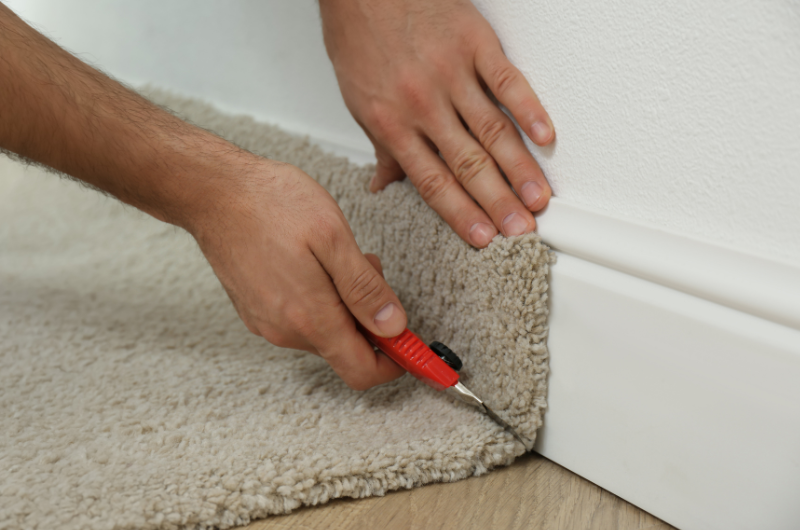When you fit new flooring, the quality of the underlay installation often determines how professional the result looks and feels. Underlay may be hidden beneath carpet, laminate or engineered wood, but it makes a huge difference.
It cushions footsteps, reduces noise, improves insulation and extends the life of your flooring. None of these benefits are achieved if the underlay is cut poorly. Around doors, skirting boards and corners, precision is essential.
If gaps are left, cold draughts and sound can travel through. If the material is overlapped or bunched, the surface above can sit unevenly. Getting the cutting right is just as important as laying the flooring itself.
Why accuracy matters
The role of underlay is to create a smooth, stable base. When it fits properly, flooring is supported evenly from wall to wall.
When it is cut too short, gaps appear that weaken insulation and allow flooring edges to shift. When it is cut too long or overlapped, ridges form that show through carpet or disrupt laminate joints.
Doorways and corners highlight these problems most clearly. Because these are high-traffic areas, small mistakes can quickly lead to visible wear. That is why accuracy is crucial in the places that are hardest to cut.
Preparing before cutting
Good preparation makes cutting easier. Start by clearing the room completely and removing old flooring and underlay. Sweep or vacuum to get rid of debris.
It is a common question whether to cut underlay before laying it down. The best approach is to position the material first and then trim it in place. This way, the cuts follow the true shape of the room.
Sharp tools are essential. A utility knife with a fresh blade will give clean cuts. A straight edge or ruler guides longer lines, while a carpenter’s square is helpful in corners. Chalk or pencil markings provide accuracy. Knee pads can make the work far more comfortable.
Cutting against skirting boards
A frequent question is how close underlay should go to the skirting. For carpet, it should fit right up to the skirting so there is no exposed floor. For laminate or engineered wood, a small expansion gap is often required.
The technique is straightforward. Place the underlay flat against the wall so it overlaps slightly. Mark the line where it meets the skirting, then cut slowly with a sharp knife. Use a straight edge to guide the blade.
Once trimmed, the underlay should sit flush. Avoid pushing it too tightly into the skirting line, because tension in the material can cause lifting later.
Working into corners
Corners are another area that require care. For square corners, press the underlay into the angle where the walls meet. A small diagonal cut at the joint helps relieve tension. Trim along each wall to create a neat finish.
Curved walls, such as those in bay windows, need a slower approach. Cut the underlay slightly oversized and trim it gradually. Cutting the curve all at once often leaves gaps. Taking small slices ensures the fit is smooth and accurate.
It is always better to cut conservatively. You can trim back more material, but you cannot replace what you have removed.
Cutting around door frames
Door frames are often the most challenging part. The method is to cut in stages rather than trying for one large shape.
Lay the underlay across the threshold so it overlaps into the next room. Press it gently into the base of the frame and mark the outline clearly. Cut along the markings with your knife, then refine the shape with smaller adjustments.
For carpet, underlay usually stops just before the threshold strip. This allows the carpet to stretch smoothly across. For laminate or wood, you also need to maintain an expansion gap. Spacers are useful for keeping that gap consistent during cutting.
Avoiding common mistakes
There are several mistakes to watch out for. A blunt blade tears the material and creates rough edges, so replace blades regularly.
Cutting pieces too short leaves gaps that cause draughts and weaken soundproofing. Cutting slightly oversized and trimming back gradually is a safer option.
Overlapping underlay sheets is another error. Overlaps create ridges that show through carpet or stop laminate from locking correctly. Sheets should always be butted edge to edge and taped securely.
Finally, never ignore the condition of the subfloor. If it is uneven, even the neatest cutting will not produce a perfect result.
Keeping the underlay secure
Another question that often arises is whether underlay needs fixing down. The answer depends on the type of flooring.
For carpet, double-sided tape is usually applied along seams and edges to keep everything in place. For laminate or wood, underlay often floats, but taped seams prevent it from shifting during installation. For vinyl, some manufacturers recommend a light adhesive for stability.
Following the flooring supplier’s instructions is always the safest route.
When to use a professional fitter
Although many people cut and fit underlay successfully, some rooms present greater challenges. Intricate alcoves, curved walls and awkward thresholds can be time-consuming and frustrating.
If the flooring is costly or if you want the most polished finish, hiring a professional can be worthwhile. A fitter brings experience and the right tools, which often makes the process quicker and neater.
Frequently asked questions
One common question is whether underlay can be pre-cut before it is placed in the room. The answer is that it should be cut once it is positioned, because this ensures a closer fit.
Another frequent query is how close underlay should be cut to the skirting. For carpet, it should touch the skirting, but for laminate or wood it should stop slightly short to leave an expansion gap.
Some ask if a special type of underlay is needed for doorways. The answer is no, but the cutting must be accurate and the edges properly secured.
Others wonder if underlay sheets should overlap. They should not. Overlap creates ridges, while butting edges together and taping them produces a smooth join.
Final thoughts
Cutting underlay neatly around doors, skirting and corners is a task that rewards patience and accuracy. By using sharp tools, trimming gradually and measuring carefully, you can achieve a professional result even as a DIYer.
The underlay is the foundation of your flooring. If it is fitted with precision, your carpet, laminate or wood floor will look better, feel more comfortable and last far longer.



